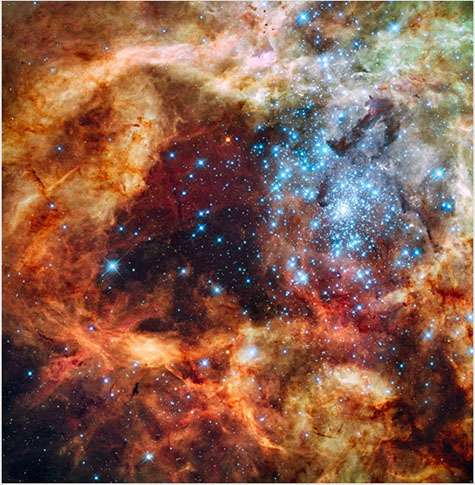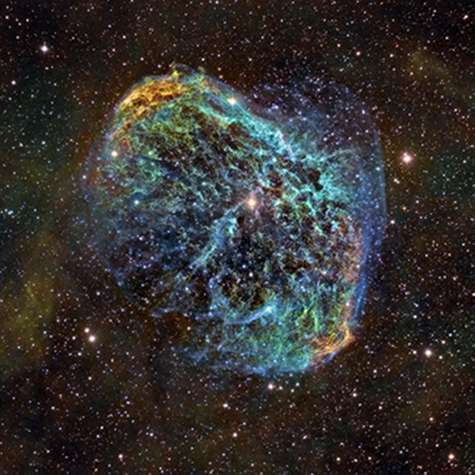Super-tiger backgrounder: The case of the cosmic rays

(Phys.org)—Grade-school science teachers sometimes hand out "mystery boxes" containing ramps, barriers and a loose marble. By rotating the boxes and feeling the marble hang up or drop, the students try to deduce what's inside the box.
Physicists trying to understand why tiny particles rain incessantly down from space face a similar dilemma, but their box is a hundred thousand light years across and their only clues are the particles themselves.
Just to make things more interesting, the particles don't travel in straight lines through the galaxy but instead follow tortuous paths that provide no clue to their starting point.
Naming the beasts
Given the difficulties, it is perhaps not surprising that it has taken nearly 100 years of detective work to partially solve the cosmic ray mystery. But scientists, now in hot pursuit, feel they are finally close to a complete solution.
Cosmic rays first became an object of curiosity at the turn of the century when the scientific world was agog with discoveries of different types of invisible radiation, including electrons, X rays, and emanations from radioactive elements.
Scientists experimenting with the new forms of radiation quickly discovered that some high-energy radiation was able to reach detectors protected by lead shielding. Where did this penetrating radiation come from? The belief spread that it was emitted by radioactive material in Earth's crust.
That view was overturned by the Austrian scientist Victor Hess, who demonstrated, during 10 high-altitude balloon flights, that the higher one went, the more penetrating radiation one encountered. The source, then, had to be extraterrestrial (cosmic) rather than earthly.
At first the radiation was thought to be gamma rays (high-energy electromagnetic radiation), which is why it was named cosmic "rays." But evidence accumulated that the rays were affected by Earth's magnetic field, which suggested the radiation consisted of charged particles instead.
Two giants of science, both Nobel laureates in physics, Robert Millikan and Arthur Holly Compton debated the issue at length, with Millikan espousing the view that cosmic rays were radiation and Compton (correctly) arguing that they were corpuscular.
Washington University has a special association with Compton. He was chair of the department of physics here from 1920-23 and awarded the Nobel Prize in Physics in 1927 for work on X-ray scattering that he did in the basement of Eads Hall at the university. He left the university in 1923 but returned here to serve as chancellor from 1945-53.
High-altitude balloons again came to the rescue, showing first that the incoming radiation consisted of protons (hydrogen nuclei) and then that there were stripped down nuclei of heavier elements among the protons.
Today we know that 90 percent of cosmic rays are hydrogen nuclei (the protons), 9 percent are helium nuclei, and the remaining 1 percent are the nuclei of heavier elements.
Most nuclei have energies between 108 and 1010 electron-volts, with the number of particles decreasing steeply at higher energies. These energies are high enough the particles zip through the galaxy at two-thirds the speed of light or faster.
Since 1962 a handful of particles with energies above 1020 electron-volts have also been spotted. These energies are so much higher than those of most cosmic rays that scientists think these extra-energtic particles must be powered by an extragalactic source, such as supermassive black hole at the center of nearby galaxy. But very little is known about them.
Tracking them to their lair
Once scientists understood what cosmic rays were, the next question was: where do they come from?
There are two parts to that question, says Martin Israel, PhD, professor of physics at Washington University and co-investigator on Super-TIGER. The first is where does all the energy come from?
"We know roughly the density of cosmic rays in the galaxy and, thanks to 'clock' nuclei among the cosmic rays, we know how long the particles wander through the galaxy before they leak out," Israel says. "Together those two measurements tell us how much energy per unit time—how much power—goes into creating cosmic rays.
"So we ask what in the galaxy is generating enough power to accelerate them, and almost certainly the only candidate is supernova explosionsthat mark the violent deaths of massive stars.
"We know how much energy is released in this type of supernova explosion and roughly how frequent the explosions are," Israel says. "And it turns out that something like 10 percent of the energy that's released in supernova explosions probably goes to accelerating cosmic rays."
The second part of the question is: where is the energy loaded onto the particles?
This time the clue is the abundance of different elements in the cosmic rays. For the most part, those abundances match the abundances of elements in the giant molecular cloud out of which the solar system condensed, called "the solar system background."
But not always. In 1997 data from ACE, a spacecraft designed to study cosmic rays and solar wind particles, showed that some isotopes are much more abundant in the cosmic rays than in the solar system background.

"The one that's far and away the outlier is the ratio of neon 22 to neon 20," says W. Robert Binns, PhD, research professor of physics and Super-TIGER principal investigator. "That turned out to be five times higher in the cosmic rays than in the solar system background, and that's a huge difference."
The abundance of neon 22 raised eyebrows because nucleosynthesis calculations and astronomical observations show it is produced copiously by Wolf-Rayet stars, a spectacular stage in the evolution of stars born with a mass greater than about 30 solar masses.
During the Wolf-Rayet stage, the stars shine so brightly the force of the light pushing outward sets up fierce stellar winds that scour the surface of the star, carrying off an Earth's-worth of material in as little as a year.
"In the winds from Wolf-Rayet Stars there's lots of neon 22," say Binns. "So once it was understood that neon 22 was overabundant in cosmic rays, it seemly likely the Wolf-Rayet stars were contributing to them.
"We couldn't account for our data," says Binns, "unless we assumed cosmic rays had two sources. One component is ordinary solar system background material, just the everyday dust and gas that's lying around out there. The other component is material from the Wolf-Rayet stars."
To make the numbers work, the physicists found they had to add two parts Wolf-Rayet material to eight parts interstellar medium.
At this point, the bigger picture was beginning to emerge. "The thing about Wolf-Rayet stars," Binns says, "is they're almost all found in loosely organized groups of hot, massive stars called OB associations."

These are clusters of stars that formed from a single interstellar cloud and are drifting together through space. Ninety percent of stars are thought to have formed in stellar associations, of which there are three types distinguished by properties of the stars they harbor.
The most massive stars are born in OB associations consisting of 10 to a few hundred stars of spectral types O and B (both massive, blue stars). High-velocity winds from the stars and supernovae explosions as they reach the ends of their short lives blow enormous cavities in the interstellar medium, from which the remaining stars shine boldly forth.
It was beginning to look like the scientists had nailed the evidence and sealed the case. The winds from the Wolf-Rayet stars were seeding the interstellar medium in OB associations with exotic isotopes which were then swept up and accelerated, together with regular solar system material, by volleys of supernovae explosions.
A mini-mystery
There is another small piece of the puzzle that both Binns and Israel bring up, in part because it is such a neat example of the methods of cosmic-ray science.
The question was: are cosmic rays stuff that was made and expelled in a supernova explosion? Or are cosmic rays stuff that was made in a supernova, spewn out into the interstellar medium, and then accelerated a million years later by the shock wave from another supernova?
And how could you possibly tell which scenario is accurate?
It turns out that nickel isotopes give the answer. Most of the nickel found in nature is in the form of two stable isotopes: nickel 58 and nickel 60. Nickel 59, however, is radioactive and not stable.
Importantly nickel 59 decays by capturing one of its own electrons, which converts a proton to a neutron, turning nickel 59 into cobalt 59.
But cosmic rays are bare nuclei, stripped of their electrons when they are accelerated to cosmic ray energies. So once nickel 59 has been accelerated, it's a stable nucleus that will last more or less indefinitely.
If nickel 59 is made in supernova explosions and accelerated promptly to cosmic ray energies, it should show up in cosmic rays. If, on the other hand, it is made in a supernova explosions and then lies around in the interstellar medium for a few million years it shouldn't be found in the cosmic rays.
Neither TIGER nor Super-TIGER can identify isotopes, but they are being measured by the CRIS instrument on the ACE. CRIS, like Super-TIGER a collaboration among Washington University, the CAlifornia Institute of Technology and NASA's Goddard Space Flight Center, was launched into orbit in 1997.
"I can show you out in the hall the ACE histogram of nickel isotopes," Israel says.
We go to look. There's a nice peak at nickel 58 and a nice peak at nickel 60 and nothing in between. In the histogram of cobalt isotopes, the missing nickel 59 reappears as cobalt 59.
"The math all works," says Binss. 'Nickel 59 has a half-life of about 76,000 years and supernova go off in OB associations roughly once every million years, so there's ample time for the nickel to decay before being accelerated."
What Super-TIGER is stalking
If scientists are pretty sure they know where cosmic rays come from, why is a WUSTL-led team currently in Antarctica lofting a two-ton instrument the size of a pool table into the polar vortex to catch more cosmic rays? What is the Super-TIGER experiment looking for?
If scientists could just order the data they wanted from a catalog, they'd ask for the abundances of all of the naturally occurring elements in the periodic table and all of their isotopes.
But when they go into the field to collect cosmic rays, this is not what they get. Out of every 100 cosmic rays they intercept, only 1 will be the nucleus of an element heavier than helium.
But most of the information about cosmic-ray origins has been gleaned from that 1 percent. So the most desirable quarry is also the most elusive quarry.
Even though Super-TIGER's predecessor, TIGER, flew for a record-breaking 31.5 days in 2001, its detector was struck by only about 300 particles of the elements between zinc and zirconium.
That's only about 10 particles per element, which didn't give the scientists a very good measure of their relative abundance. "Look at the size of those error bars," Binns says pointing to a graph of the data with a grimace of chagrin.
Super-TIGER, which is much bigger than TIGER, should catch nearly eight times cosmic rays, if it can only stay up as long. That would give the scientists much better "statistics."
"You'll also notice," says Israel, "that when I talk about supernova blasts accelerating the particles I'm waving my arms a lot."
While scientists are nearly certain supernova blasts are the acceleration engine, nobody is sure exactly how this works. But Binns and Israel think a clue is beginning to emerge from the cosmic ray data.
It has to do with gas and dust. There isn't much of anything in space, but it isn't empty. There is a little gas—about one gas atom per cubic centimeter –and a sprinkle of dust—not dust as in dust bunnies but tiny grains of stuff like sand or ice.
The data are suggesting that when the interstellar medium is accelerated, the dust somehow gets the jump on the gas. An acceleration mechanism that would make this distinction has been proposed. It predicts that heavier volatiles (the gas) should have higher cosmic-ray/ solar system ratios than lighter ones, but that the refractories (the dust) would not display mass dependence.
"However, our TIGER data indicate similar (but not identical) mass dependence for both the volatiles and refractories," says Israel. "So one of the main things we are looking for with Super-TIGER is improved statistics for the heaviest elements, so that we can pin down the refractory mass-dependence."
Victor Hess would have understood. When he went up in his balloons to measure cosmic rays, he was repeating an earlier experiment. In 1919 Theordor Wulf, a German scientist, had carried a detector to the top of the Eiffel Tower in Paris and found that radiation decreased rather than increased as he ascended.
Hess ascended to 17,000 feet, more than 30 times higher than the Eiffel tower is tall because he suspected that better statistics were needed. He was right.
Provided by Washington University in St. Louis





















